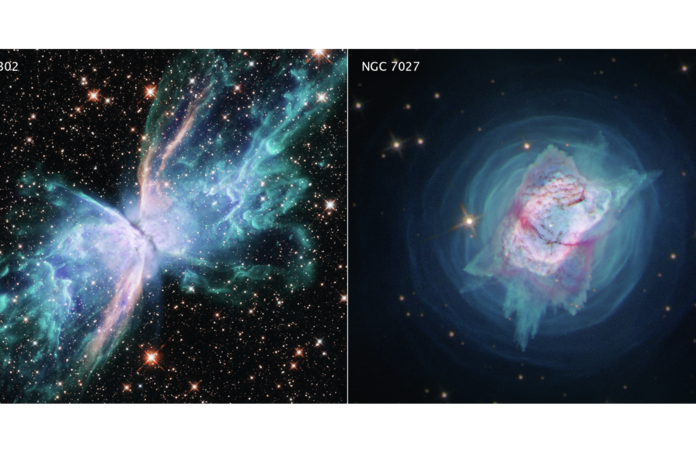Spectacular Hubble Images Reveal the Chaotic Deaths of Stars

New high-resolution, multi-wavelength images from the Hubble Telescope have provided astronomers insight into the chaotic deaths of massive and gassy stars.
The images Hubble captured were from two planetary nebulas: NGC 6303, or the Butterfly Nebula, and NGC 7027, nicknamed the ‘Jewel Bug’ Nebula. Planetary nebulas slowly shed their layers over thousands of years, shooting out massive plumes of dust and gas—which are both breathtaking to observe and vastly informative for science. With Hubble’s ability to capture images in multiple complex wavelengths, a team of astronomers was able to study both nebulae in greater detail than ever before.
Hubble
"When I looked in the Hubble archive and realized no one had observed these nebulas with Hubble's Wide Field Camera 3 across its full wavelength range, I was floored," said Joel Kastner of the Rochester Institute of Technology, the lead author of the study. "These new multi-wavelength Hubble observations provide the most comprehensive view to date of both of these spectacular nebulas. As I was downloading the resulting images, I felt like a kid in a candy store."
The images revealed a mountain of important information about the nebulae and the stars within. The team found that both of the nebulas were formed similarly—from two central stars closely interacting with each other. They also found that they’re shedding their layers at an unusually fast pace and that one of the stars may be merging with its neighbor. Kastner mentions that “the nebula NGC 7027 shows emission at an incredibly large number of different wavelengths, each of which highlights not only a specific chemical element in the nebula, but also the significant, ongoing changes in its structure.”
Shapes of the Nebulas
The researchers also believe the shapes of nebulas provide further evidence of their internal structure. The nebulas both have a pinched center with polar lobes and form complex patterns, suggesting each contains (or contained) a binary system, with two central stars locked in a close orbit. The two stars are close enough to interact, which eventually forms a large gas disk that surrounds one or both of them. The gas disk then blasts out from the stars in both directions, creating the lobe-like appearance.
"The suspected companion stars in NGC 6302 and NGC 7027 haven't been directly detected because they are next to, or perhaps have already been swallowed by, larger red giant stars, a type of star that is hundreds to thousands of times brighter than the Sun," said Bruce Balick of the University of Washington in Seattle, a co-author on the study. "The hypothesis of merging stars seems the best and simplest explanation for the features seen in the most active and symmetric planetary nebulas. It's a powerful unifying concept, so far without rival."
The team's research was published in the scientific journal Galaxies and is also freely available online.
